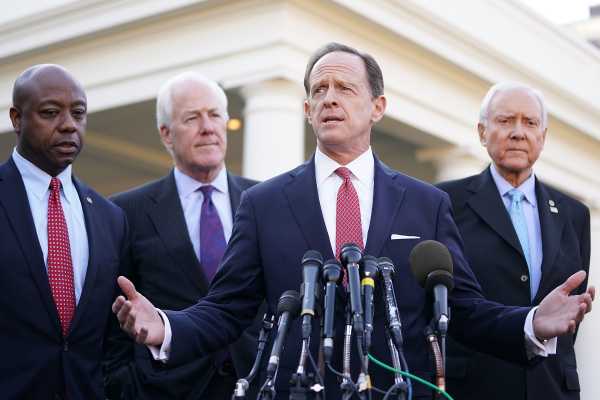
Republicans in Washington — having funded the government for six months, passed their tax law, and failed to repeal Obamacare — have an opening ahead of the 2018 midterm elections for another top priority: deregulating the administrative state.
They appear to have found a clever tool to achieve that goal: a novel use of the Congressional Review Act, the 1996 law that gives Congress extensive power to invalidate rules established by federal agencies and, in doing so, making it more difficult for any future administrations to resurrect the policies that lawmakers have struck down.
Republicans already worked overtime to undo the Obama administration’s last-minute regulations during the first 60 legislative days of the Trump administration. That was under the more conventional understanding of the CRA, which states that Congress has 60 days after a rule takes effect to pass a resolution disapproving it.
But GOP lawmakers are now using a new wrinkle in the CRA, one that would allow them to go back much further and nix much older federal rules — some of which have been in place for decades. Under the law, in order for a rule to be considered in effect, it must have been submitted to Congress for review. If a rule hasn’t been submitted, then it isn’t technically in effect for the CRA’s purposes — which means the Trump administration could submit it now and start the 60-day clock for Congress to pass a resolution invalidating it.
“Any rule that was not submitted since this act became law in 1996 can be nullified now,” Paul Larkin, a senior legal fellow at the conservative Heritage Foundation, who wrote a Harvard Journal of Law and Public policy article outlining how the CRA could be used this way, told me. Hundreds or thousands of existing federal rules could be vulnerable, per the best available estimates.
Larkin and Republican aides on Capitol Hill say the primary goal here is to hold the executive branch accountable: The point of the CRA is to give Congress oversight of the rules that an administration puts into effect. “If the agency didn’t submit it to Congress, the agency acted unlawfully,” Larkin said.
But GOP aides and law experts also acknowledge a secondary effect: If a federal rule is invalidated under the CRA, future administrations are barred from creating a new rule that is “substantially similar” to the one that was disapproved of. So for the rest of time, agencies will be limited if they try to create new regulations on the same subject.
“It’s another way of throwing sand into the gears of the administrative state,” Nicholas Bagley, a law professor at the University of Michigan, told me. “It’s a backdoor way for Congress to circumscribe agencies’ substantive power in the future.”
The Senate approved its first CRA of a years-old federal rule last week, overturning a guidance from the Consumer Financial Protection Bureau related to racial discrimination in auto lending from 2013. The question now is: Was that a one-and-done? Or was it the start of a bigger crusade while Republicans still control all three branches of government? There is only so much time available on the Senate floor, after all.
Because some Republicans and outside conservatives are already entertaining plans to overturn even more federal rules with this shiny new tool they have at their disposal.
The Congressional Review Act, explained in brief
The CRA passed in 1996, about a decade after the legislative veto — the broad right of Congress to overturn actions taken by the executive branch — was found unconstitutional by the Supreme Court. Once a new federal rule, which could be either a formal regulation or a more general “policy guidance,” a distinction that will prove important, is published in the federal registrar and submitted to Congress, lawmakers have 60 legislative days to pass a resolution overturning it under the law.
The resolution needs only a bare majority in both chambers of Congress, meaning it is not subject to a 60-vote filibuster in the Senate.
“Why did Congress want the legislative veto and the CRA? They thought there were times agencies took actions that were unlawful or unwise,” Larkin told me, “and they wanted to be able to act before those actions started to injure people.”
For a long time, there wasn’t much use for the CRA. As Vox’s Brad Plumer wrote last year, the only successful CRA resolution before 2017 was in 2001. You would need a change of power in the White House and the same party to control both the executive branch and Congress for the CRA to be of much use — and the party in power would probably need to be Republican, whose members are much more fixated on deregulation.
That moment came in 2017. Republicans used the CRA to overturn 14 regulations that the Obama administration approved in its final weeks, with a particular emphasis on the Environmental Protection Agency’s regulations.
Most people thought there was a hard deadline on that effort, given the 60-day restriction. But some conservative scholars like Larkin and Republicans in the Senate saw the opening for an even more aggressive campaign to roll back federal rules.
How Republicans can use the CRA to repeal decades-old federal rules
The wrinkle lies in the CRA and the law’s requirement that federal rules be submitted to Congress in order for the 60-day clock to start. If a rule isn’t submitted to Congress, then it isn’t actually in effect as far as the CRA is concerned, even if it is for all intents and purposes being enforced in the real world.
This is also where the distinction between regulations and policy guidances is important. Regulations go through a formal rulemaking process, and once the 60-day window closes, the Trump administration would need to go through its own rulemaking process to overturn a regulation enacted by the Obama administration.
Policy guidances are less formal: They are simply a statement of an administration’s policy positions and how its agencies will enforce the law. They do often have the same effect on the industries being regulated, who want to comply with their regulators — which can be grating to some conservatives who think liberal administrations like Obama’s have used the policy guidances to create regulations without going through formal rulemaking.
Conservatives would also note that guidances are also not subject to litigation by the regulated industries in the same way that official regulations would be.
“What agencies are trying to do, in some instances, is empire build and do it in a way that keeps a private party that could be hurt from going to court,” Larkin said.
But most importantly, policy guidances are often not submitted to Congress by the executive branch. Which means that for them, the CRA clock hasn’t started yet — and if they were submitted by the Trump administration, Congress would have an opportunity to overturn them.
Even if they had been in effect for years or even decades, all the way back to 1996 when the CRA passed.
“It’s an adventurous use of it,” Bagley told me.
But nobody I talked to really disputed that this was a valid interpretation of the CRA. The Government Accountability Office, the arbiter of this issue for Congress’s purposes, agreed with Republican Sen. Pat Toomey’s office that the auto lending guidance that Congress has now invalidated had not been properly submitted and could therefore be subject to a CRA resolution. There is also evidence that the Democrats in Congress who helped pass the law thought it could be used this way.
There were some questions, though, about how appropriate it is. There is a public interest, a few legal experts argued to me, in having agencies publicly state their policy positions. If this use of the CRA discourages that, it is a loss for transparency in government.
“It’s a tricky way of exploiting some ambiguity in the law to ram some things through with their majority in Congress right now,” Jeff Lubbers, a law professor at American University, told me. “I think it’s really bad policy and bad government.”
The counter from conservatives: This is what agencies are supposed to do, to give Congress its chance to oversee the rules being promulgated by the executive branch. If they didn’t follow the proper procedures, then too bad. They hope passing a CRA resolution in these circumstances will encourage compliance by federal agencies in the future.
The real impact of Congress overturning federal rules under the CRA
There is one other bit of weirdness that we haven’t covered yet: Because policy guidances aren’t official regulations, they can be withdrawn at any time without going through the arduous rulemaking process that you must endure to reverse an official regulation. If Mick Mulvaney, currently leading the CFPB, wanted to end the auto lending rule, he could have done it all on his own.
“From a lawyer’s perspective, they never had any effect to begin with anyhow,” Bagley said. Sure, policy guidances usually induce compliance — because industries don’t want to run afoul of the federal government — but they don’t technically have any legal effect. Ever.
So why have Congress pass a CRA resolution? Legal experts searching for an explanation spotted the law’s “salt the earth” provision. Once a rule is disapproved of, agencies are forever barred from passing a similar regulation.
“The CRA has this provision that salts the earth. It says that no substantially similar rule can ever be adopted again. I take it that is what the real stakes are here,” one legal scholar who asked not to be quoted by name told me. “It’s really that in any future administration, when and if Elizabeth Warren is president, they’re still not going to be able to adopt any rule that is substantially similar to this guidance.”
Now, nobody knows exactly what “substantially similar” means. It probably wouldn’t make it impossible for a Warren or Sanders administration to craft a federal regulation barring racial discrimination in auto lending, even after the Senate approved last week’s CRA resolution.
But it will make the rulemaking process more cumbersome. Regulators will have to take pains to avoid those substantially similar criteria. As Bagley put it, it throws sand in the gears of the administrative state — which is certainly in line with conservative ideology.
Now we wait and see whether more CRA resolutions to overturn old policy guidances are brought forward. Larkin told me he was preparing a list of suggestions for Republicans in Congress and the Trump administration: rules that would hinder the economy and should be thrown out, rules that should be kept but should be submitted to comply with the CRA, etc. and so forth.
“It may be true now that the Senate has taken this approach, other senators will go forward with a challenge to rules that have a greater effect in their state,” he said. “It wouldn’t surprise me to see the staffs of the White House, House speaker, and Senate majority leader put a list together. ‘Here are rules that people have said we should consider.’”
Politico reported that Sen. Lisa Murkowski (R-AK) has already inquired whether a 2016 Bureau of Land Management plan could still be subject to the CRA. Conservative health wonk Chris Jacobs put together a list of Obamacare rules that could potentially fall under this use of the CRA.
In the ongoing battle over how rigorously American industries should be regulated, Republicans have a found a powerful new weapon.
Sourse: vox.com






